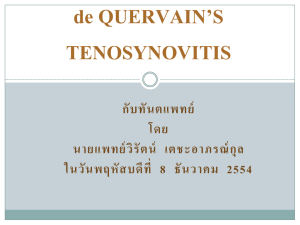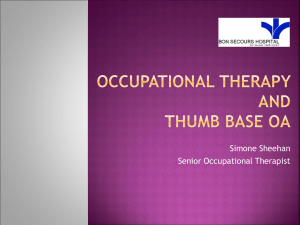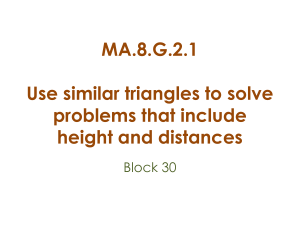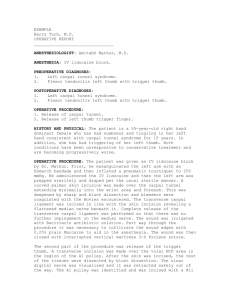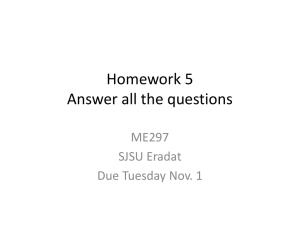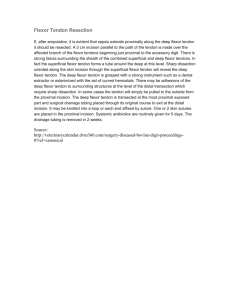Undergrowth
advertisement
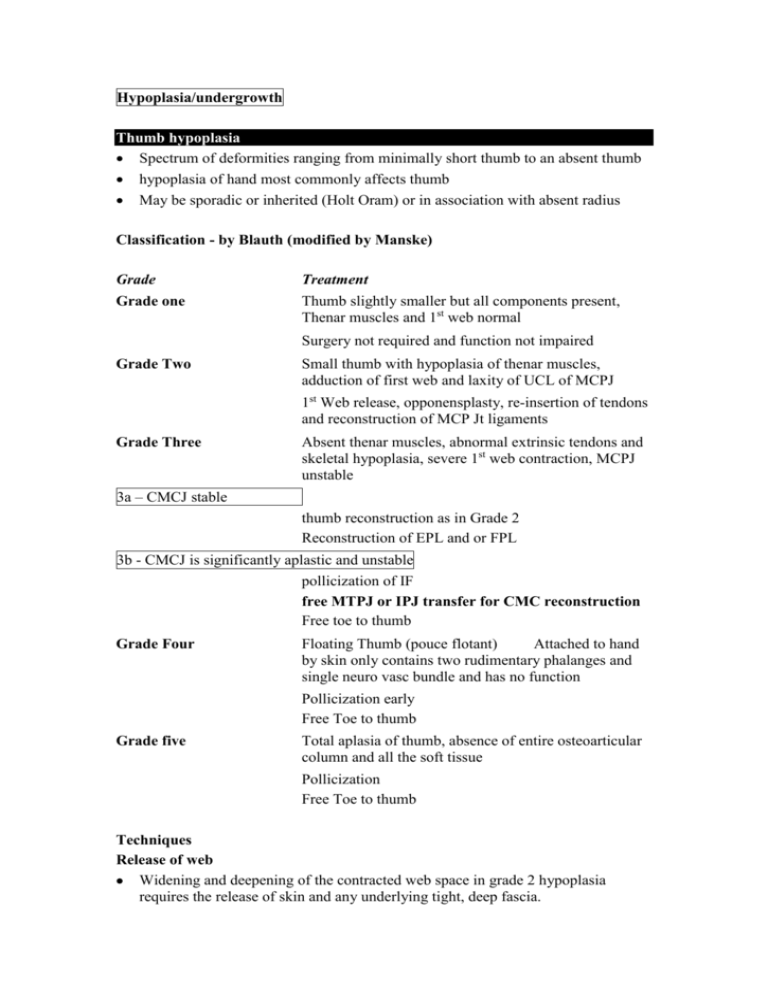
Hypoplasia/undergrowth Thumb hypoplasia Spectrum of deformities ranging from minimally short thumb to an absent thumb hypoplasia of hand most commonly affects thumb May be sporadic or inherited (Holt Oram) or in association with absent radius Classification - by Blauth (modified by Manske) Grade Treatment Grade one Thumb slightly smaller but all components present, Thenar muscles and 1st web normal Surgery not required and function not impaired Grade Two Small thumb with hypoplasia of thenar muscles, adduction of first web and laxity of UCL of MCPJ 1st Web release, opponensplasty, re-insertion of tendons and reconstruction of MCP Jt ligaments Grade Three Absent thenar muscles, abnormal extrinsic tendons and skeletal hypoplasia, severe 1st web contraction, MCPJ unstable 3a – CMCJ stable thumb reconstruction as in Grade 2 Reconstruction of EPL and or FPL 3b - CMCJ is significantly aplastic and unstable pollicization of IF free MTPJ or IPJ transfer for CMC reconstruction Free toe to thumb Grade Four Floating Thumb (pouce flotant) Attached to hand by skin only contains two rudimentary phalanges and single neuro vasc bundle and has no function Pollicization early Free Toe to thumb Grade five Total aplasia of thumb, absence of entire osteoarticular column and all the soft tissue Pollicization Free Toe to thumb Techniques Release of web Widening and deepening of the contracted web space in grade 2 hypoplasia requires the release of skin and any underlying tight, deep fascia. Z plasty - Zplasty, or four flap z-pasty may improve mild contractures only Local flaps – dorsal transposition flap from the dorsum of the index finger may be required. The donor defect is covered by FTSG Regional flaps – Reverse radial forearm Free flaps – groin flap Opponensplasty: Restoration of opposition requires transfer of an active muscle unit. The superficial tendon of the ring finger or the abductor digiti minimi can be used. FDS to RF has better excursion FDS exposed though incision through proximal digital crease and retrieved distal to the flexor retinaculum and rerouted to be looped through the proximal phalanx and the distal metacarpal, thus reconstructing the lax UCL Huber transfer - Abductor digiti minimi is passed through a tunnel and sutured to the hypoplastic abd pollicus brevis. Stabilization of MCP Joint When the UCL is lax, may be reinforced with a tendon graft. Usually sutured to thick periosteum. If holes required in bone care taken not to damage the growing epiphysis Stabilization difficult in setting of hypoplastic muscles thus arthrodesis may be required. Tendon adjustment When the normal skin crease of the thumb is absent or poorly developed, or when there is deviation of the distal interphalangeal joint, anomalies of the extrinsic tendons may be present. In some cases where the thenar muscles are absent, the FPL may run a very superficial course, connecting with the extensor pollicus longus and brevis tendons and inserting in to the lateral digital sheet to exert an abduction force on the distal phalanx. Useful flex and ext may not be possible and this complex may exert a powerful abductor force in poorly stabilized joints of the thumb. The anomalous flexor extensor connection (pollex abductus) needs division. The power of the existing may be improved by reinsertion of the tendon. Pollicization – Buck gramcko Timing - 1st year of life Theoretical concepts In creating a new thumb with stability and optimum length a reduction in the length of the bones is important. Thus the second metacarpal except its head is removed. The head acts a trapezium and thus attaining the same number of bones as a thumb The metacarpal should not be allowed to grow much thus the epiphysis is removed Rotation of the IF on its longitudinal axis is also performed to provide proper axial alignment The IF needs to be rotated 160 so it is opposite to the pulp of the RF during suturing the rotation ends up at about 120 degrees MCPJ should be in 40 of palmar abduction, 15of extension and 120of pronation Operative technique Four important techniques relating to the following 1. the neurovasc pedicle 2. skeletal readjustment with the preservation of the MCP joint 3. muscular stabilization 4. the skin incision The N/V bundle Freeing up the NV bundle between the IF and RF obtained by ligating the proper digital artery to the radial side of the long finger. The radial artery to the IF is often small or absent The common digital nerve is then carefully separated into its component parts of the two adjacent fingers Occasionally there is a Hartmanns boutonniere, where the common digital artery passes through the digital nerve – do internal neurolysis to mobilize but try not to cut the nerve On the dorsal side at least one of the great veins must be preserved The skeletal readjustment 1) The Transverse metacarpal ligament is divided and the metacarpal shaft is exposed to allow excision. 2) The ideal length of the new thumb should meet the MF PIPJ crease in adduction 3) Intrinsics are stripped off the shaft up to proximal 1/3 to preserve nerve supply, their distal tendons divided and metacarpal head is excised 4) Presence of 1st dorsal interossei and lumbrical is key for a good result 5) The physis is curreted to destroy growth potential and the head is fixed by sutures to the joint capsule and the carpal bones. 2 Kwires are used. 6) The head is rotated 70 -80 degrees such that its palmar side becomes more proximal (see figure) ie the prox phalanx is brought into a position of hypertextension with respect to the proximal phalanx and thus prevents hyperextension deformity. 7) The IF is also rotated by 160 degrees Skin incisions At the base of the index finger an incision is fashioned to form a long 70 V on the dorsal aspect extending to a point overlying the neck of the metacarpal. 1/3rd from the apex to the ulnar midlateral line, a longitudinal incision is made extending to the index PIPJ (line B) It is carried through skin only to preserve vessels and nerves. Curvilinear palmar incision from midpoint of the digital crease incision to the distal wrist crease Both neurovascular bundles are kept intact if present, however one is usually dominant. On the ulnar side of the digit the nerve is dissected from the common digital nerve towards the base of the palm. The arterial branch to the radial side of the middle finger is ligated to mobilize the ulnar digital vessel of the index finger. On the dorsal aspect two veins should be preserved Tendon transfers/ muscle stabilization The intrinsic and extrinsics are essential for the stability of the operation the EDC is cut at the MCP joint level and prox end sutured to the base of the former prox phalanx now acting as a MC to become the new abductor pollicus longus The EI tendon is divided and shortened (to length of metacarpus shortening) and then resutured to act as a EPL The interossei are divided distally and their origin is carefully stripped of the metacarpal shaft in subperiosteal dissection. They are then sutured to the two lateral bands Tendon of first dorsal interosseous is moved distally and sutured to the radial lateral band to function as short abductor. If this absent (50%), suture EDC more distally and volarly to the proximal phalanx shaft Later, FDS or ADM opponenplasty may be done st 1 palmar interosseous tendon is sutured to ulna side lateral band to act as adductor The two flexor tendons do not need to be shortened in young because they readjust over 6mths in older children shortening speeds recovery Summary 1. EDC sutured to P1 to become APL 2. EI sutured to EPL (if present) 3. 1st DI and lumbrical to radial lateral band 4. 1st VI to ulnar lateral band Postoperative management Well padded dressing applied with plaster in older children Dressing and k wire removed at 4 wks Taping the remaning digits or wearing a mitten will encourage prehensile use of the new thumb takes upto 6 mths to achieve final functional result Improved with judicious hand therapy Complications Necrosis due to tight dressings, hematoma or vessel thrombosis (rare complication) Marginal flap necrosis Joint imbalance - if metacarpal head is not rotated to prevent hyper ext of the thumb Tendon imbalance Nerve supply to dorsal interosseous damaged - corrected with FDS opponensplasty Grade IIIa reconstruction with toe joint transfer extrinsic tendon abnormalities includes absent extensor pollicis longus tendon, absent or aberrant flexor pollicis longus tendon, tendon interconnection between the flexor pollicis longus and extensor aponeurosis, duplication of musculotendinous units, anomalous muscles between the thumb and index rays, and abnormal insertions or dense adhesions along tendons as proximal as the forearm level. Repair requires 1. extended approach from the digit to the forearm, through which division of abnormal connections, reorientation of tendons, and lysis of adhesions was performed. 2. If EPL/FPL absent, reconstruct 3. UCL reconstruction of MCJ 4. 1st web space widening 5. opponensplasty if required Grade IIIb with joint transfer functionally and cosmetically inferior to the ones observed after pollicization. Use vascularized second toe proximal interphalangeal joint transfer for carpometacarpal joint replacement Otherwise similar to IIIa repair May need to perform in 2 stages Free toe transfer 2nd toe and metatarsal head often used Avoid use of 1st toe due to sacrifice of the metatarsal head Similar concepts to pollicisation but with the micro Opponensplasty required Hypoplastic digits Short under developed digits associated with many cong hand deformities Usually digits are skin tubes with deficient underlying structures Treatments involve free phalangeal transfer from toes or distraction lengthening
